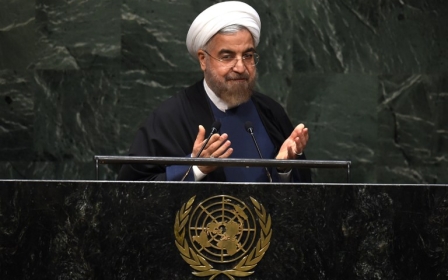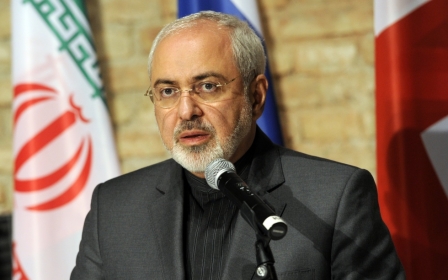Iran, Saudi Arabia, Mid-East arch-rivals find common ground on IS

The Iranian nuclear delegation rounded up 10 days of intensive talks with no breakthrough and left New York on 27 September. But a long-awaited rapprochement between Tehran and Riyadh remained a key development which happened on the side lines.
This latest round of talks between Iranian officials and representatives from major world powers (United States, Russia, China, United Kingdom, and France, plus Germany) came as officials from both sides had cautioned ahead of the talks that a breakthrough was unlikely to bring an end to the sanctions imposed on Tehran, although they had hoped substantial progress could be made in narrowing disagreements.
Iranian President, Hassan Rouhani also was in New York, as leaders from around the world convened for the 69th UN General Assembly (UNGA). Rouhani’s address to the UNGA followed his meeting with British Prime Minister, David Cameron which was the first sit-down between an Iranian and British leader since Iran’s Islamic Revolution in 1979.
In another high-level meeting, for the first time after pragmatist Hassan Rouhani was elected as president of Iran last year, Foreign Minister, Javad Zarif met his Saudi counterpart, Saud al-Faisal on 21 September.
Zarif, whose pragmatic style of diplomacy has impacted many politicians, after the meeting said: “Both my Saudi counterpart and I believe that this meeting will be the first page of a new chapter in our two countries’ relations.” He further expressed hope that the meeting would have a positive impact on efforts to restore peace to the region and the world, and protect the interests of all Muslim nations.
“We are aware of the importance and sensitivity of this crisis and the opportunity we have ahead of us,” said Saudi Foreign Minister, Saud al-Faisal following his negotiation with Zarif. “We believe that by using this precious opportunity and avoiding the mistakes of the past, we can deal with this crisis successfully.”
What Saud al-Faisal referred to as “crisis” is the threat from the Islamic State (IS), which has apparently convinced the two rivals on the opposing poles of Middle East power politics to be driven to cooperate with each other. The extremist jihadist group which claims foundation of an Islamic Caliphate or a self-declared “Islamic State” has sent shockwaves across the entire world during recent months after it advanced significantly deep into Syria and Iraq, killing many civilians, performing medieval executions of its prisoners, and beheading two American journalists and a British aid worker on video - what finally led the US and its allies to interfere and start targeting the group’s strongholds both in Iraq and later in Syria.
Following the meeting between the two foreign ministers, President Rouhani said on 23 September that he looked forward to better relations with Saudi Arabia. “Our relationship with Saudi Arabia is not within the level that our people expect. I believe relations deserve to be warmer,” Rouhani said. He further said he believed Riyadh was moving “closer and closer with us” as a result of the conditions in the region - an apparent reference to IS’s advances. “Within the next few months, I believe our relations will grow warmer,” he added.
Root causes of rivalry
Both Shiite Iran and Sunni Saudi Arabia have long seen themselves as heralds of world Muslims. During the 1970’s, Mohammad Reza Shah of Iran was the US’s close ally in the region, but the relations between the two “monarchies” were stable. The revolution in Iran lead by Shiite clerics was seen in Riyadh as a threat, and Saudis feared their intent to export the Islamic Revolution.
During the 1980-1988 Iran-Iraq war, Saudis supported Saddam Hussein. The relations between Iran and Saudis was even more exacerbated in July 1987 when 402 pilgrims, 275 of them Iranian, were killed during clashes in Mecca. Protesters in Tehran occupied the Saudi embassy and set fire to Kuwait’s embassy. A Saudi diplomat died in Tehran of wounds sustained when he fell out of an embassy window. King Fahd cut Saudi’s diplomatic relations with Iran and ensured that no Iranian could obtain a travel visa for performing the Hajj.
The Iran-Saudi relationship improved significantly during the presidencies of Akbar Hashemi Rafsanjani (1989-1997) and Mohammad Khatami (1997-2005). Crown Prince Abdullah visited Iran for an Islamic summit in December 1997, becoming the highest-ranking Saudi to do so since the Islamic Revolution. Khatami further worked for rapprochement with Riyadh and visited Saudi Arabia in 1999, the first such trip in two decades.
In 2005, hardliner Mahmoud Ahmadinejad came to power in Iran which strayed relations between the two countries. Meanwhile, King Abdullah officially took power, which led Saudi Arabia to undertake a more active foreign policy that put Riyadh more at odds with Tehran.
The atmosphere changed to be even gloomier. A US diplomatic cable leaked by Wikileaks in 2008, detailed a meeting between General David Petraeus, then US ambassador to Iraq, Ryan Crocker, and King Abdullah and other Saudi princes. At the meeting, the Saudi ambassador to the United States, Adel al-Jubeir “recalled the King’s frequent exhortations to the US to attack Iran and so put an end to its nuclear weapons program,” the cable said. “He told you to cut off the head of the snake,” Jubeir was reported to have said.
Three years later, the United States said it had uncovered an Iran-backed plot to assassinate the Saudi ambassador to Washington. Riyadh said Tehran would pay a price while Iran rejected the claim as a fabrication.
Since protests started in Syria and then changed to a civil war between President Bashar al-Assad - Iran’s ally - and the opposition forces - that were supported by the Kingdom - the two arch rivals have been even more at loggerheads.
The way ahead
For the first time in a decade, Iran and Saudi Arabia aligned last month, as they welcomed Heidar al-Abadi as Iraq’s new prime minister, taking over from the two-term prime minister, Nuri al-Maliki. Iran dropped its support for Maliki as protests erupted among Iraqi Sunnis and Kurds against his ruling, paving the way for the formation of the new government.
President Rouhani has stressed on regionalism and improvement of ties with neighbouring countries from the first days he took office. In late August 2014, Iran Deputy Foreign Minister, Hossein Amir-Abdollahian, visited Riyadh and discussed “matters of common interest” with Saudi Foreign Minister, Prince Saud al-Faisal. It was the first trip by a high-level official from Iran to Saudi Arabia since Hassan Rouhani became the Islamic Republic’s president in August 2013. The visit led up to the recent meeting between the two countries’ foreign ministers in New York.
Less than two weeks before the Iranian deputy foreign minister visited Saudi Arabia, Tehran finally sent a new ambassador to Riyadh. The new Iranian ambassador, Hossein Sadeghi, was welcomed by the Saudis. He is the brother-in-law of former president Mohammad Khatami, who sent him to Riyadh as his ambassador during his presidency. That period is considered to be golden era in Iranian-Saudi relations.
The return of Sadeghi to Riyadh was considered a sign of the end to the eight years of Ahmadinejad’s severe approach to Saudi Arabia.
I his op-ed for the government-owned “Iran” newspaper (published on the same day that the Iranian delegation left New York), Sadeghi described the reasons the two countries need to “formulate a new strategy and framework for setting bilateral relations.”
He wrote, Iran-Saudi relations need a new framework due to the geopolitical and strategic status they have in the regional and international sphere, the important and effective role they play in the Islamic world and the common economic interests they have in the oil market. “The current common threat to the regional security and stability makes it necessary for both countries to base their endeavours in expanding their political and religious sphere of influence on a win-win formula,” the ambassador wrote.
As the two rivals are finding margins for cooperation, there remain major challenges they do face on the ground - Syria the most important one. Lina Khatib, director of the Carnegie Middle East Centre in Beirut, believes that IS is a shared enemy for Iran and Saudi Arabia, which presents an opportunity for both countries to begin a process of political compromise on Syria, as long as they can find a formula for governing Syria that would retain their respective strategic interests in the country. “While no such formula currently exists, the IS threat is likely to push them to further cooperation, which can pave the way for the creation of this formula in the future,” she said talking to Middle East Eye.
It seems that the two regional rivals have realised the might of their “shared enemy” and decided to overcome disputes and narrow the gap between them.
“We should consider this reality that the differences between the two sides do not necessarily mean that there are no joint ground for cooperation. Iran and Saudi Arabia would be able to understand the current threats and cooperate in those areas they face common threats,” Sadeghi wrote in his op-ed.
This can be assumed as the new “framework” the two countries have agreed upon recently and which would drive them to overcome at least a part of their regional disputes.
New MEE newsletter: Jerusalem Dispatch
Sign up to get the latest insights and analysis on Israel-Palestine, alongside Turkey Unpacked and other MEE newsletters
Middle East Eye delivers independent and unrivalled coverage and analysis of the Middle East, North Africa and beyond. To learn more about republishing this content and the associated fees, please fill out this form. More about MEE can be found here.




